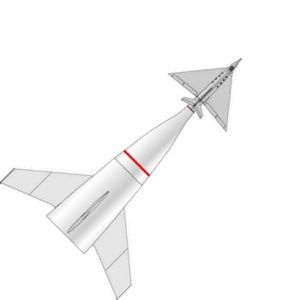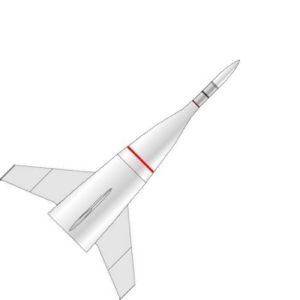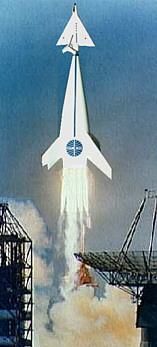
Home - Search - Browse - Alphabetic Index: 0- 1- 2- 3- 4- 5- 6- 7- 8- 9
A- B- C- D- E- F- G- H- I- J- K- L- M- N- O- P- Q- R- S- T- U- V- W- X- Y- Z
Von Braun 1956
 Von Braun 1956 Credit: © Mark Wade |
AKA: A12. Status: Study 1956. Payload: 13,600 kg (29,900 lb). Thrust: 23,900.00 kN (5,372,900 lbf). Gross mass: 1,280,000 kg (2,820,000 lb). Height: 97.00 m (318.00 ft). Diameter: 20.00 m (65.00 ft). Apogee: 102 km (63 mi).
By 1956 Von Braun was just months away from the first launch of his Jupiter ballistic missile and sketching what would become the Saturn I launch vehicle. His design group clearly knew that any real launch vehicle would consist of simple cylindrical bodies. Fins had been entirely deleted on the Jupiter and Saturn designs.
However Von Braun, or his collaborator Willy Ley, did not bring their nominal space launch vehicle up to date. The design presented in print and television in 1955-1957 was simply a small-scale version of the 1952 design. The first and second stages were simply reduced to 20% of their former size. The expendable third stage was tiny, equivalent to the Agena stage then under secret development. Its main purpose was to maintain the burn-our velocity of the second stage as calculated in 1948. In this way the 1948 calculations could remain sub-orbital and recoverable. The manned glider became a separate payload, that could be replaced by an 'all cargo' module. The only nod to modernity was that the glider was now delta-winged, a better solution for a vehicle that had to be stable over a wide range of airspeeds.
LEO Payload: 13,600 kg (29,900 lb) to a 102 km orbit at 23.50 degrees.
Stage Data - Von Braun 1956
- Stage 1. 1 x Von Braun 1956-1. Gross Mass: 1,100,000 kg (2,400,000 lb). Empty Mass: 140,000 kg (300,000 lb). Thrust (vac): 28,257.800 kN (6,352,606 lbf). Isp: 257 sec. Burn time: 84 sec. Isp(sl): 217 sec. Diameter: 11.70 m (38.30 ft). Span: 36.00 m (118.00 ft). Length: 22.20 m (72.80 ft). Propellants: Nitric acid/UDMH. No Engines: 29. Status: Study 1956.
- Stage 2. 1 x Von Braun 1956-2. Gross Mass: 154,000 kg (339,000 lb). Empty Mass: 14,000 kg (30,000 lb). Thrust (vac): 3,254.230 kN (731,580 lbf). Isp: 297 sec. Burn time: 124 sec. Diameter: 7.80 m (25.50 ft). Span: 7.80 m (25.50 ft). Length: 16.90 m (55.40 ft). Propellants: Nitric acid/UDMH. No Engines: 8. Status: Study 1956.
- Stage 3. 1 x Von Braun 1956-3. Gross Mass: 12,400 kg (27,300 lb). Empty Mass: 2,100 kg (4,600 lb). Thrust (vac): 406.770 kN (91,446 lbf). Isp: 297 sec. Burn time: 73 sec. Diameter: 2.14 m (7.02 ft). Span: 2.14 m (7.02 ft). Length: 2.90 m (9.50 ft). Propellants: Nitric acid/UDMH. No Engines: 1. Status: Study 1956.
Family: orbital launch vehicle, Winged. People: von Braun. Country: Germany. Stages: Von Braun 1956-3, Von Braun 1956-2, Von Braun 1956-1. Bibliography: 218.
 | Von Braun 1956 (carg Credit: © Mark Wade |
 | launch of Von Braun Credit: © Mark Wade |
Back to top of page
Home - Search - Browse - Alphabetic Index: 0- 1- 2- 3- 4- 5- 6- 7- 8- 9
A- B- C- D- E- F- G- H- I- J- K- L- M- N- O- P- Q- R- S- T- U- V- W- X- Y- Z
© 1997-2019 Mark Wade - Contact
© / Conditions for Use